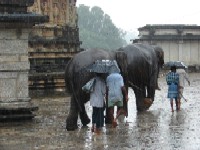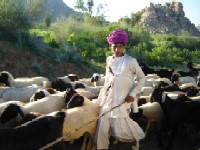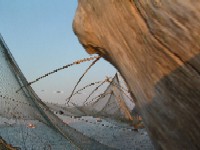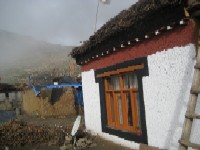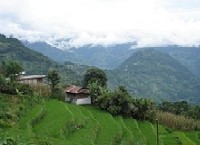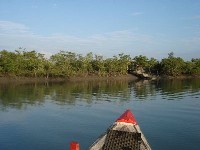
pic: rare, but the rain clouds were following us whereever we went to:
After stopping at the monastery for few minutes, we trekked down to the valley and then started the slow climb towards Langza. During the walk through the entire stretch, we saw several hundreds of fossils, which looked almost like a work of art. Considered to be one of the most fossiliferous regions of the world, Spiti Valley tells us the story behind the trilobites and ammonites that were formed after the collision of Indo-Eurasian sub-continent.

While observing the beauty of the fossils lying in the streams and nearby valleys, one can't just stop for a second and think, 'Oh my, how could I believe that this entire mountain stretch that we stand now at around 4,300 MSL was part of Tethys sea some 200 million years before!' Geologists say that the larger continent of Pangea started to split into various land masses as a result of which, the two main land masses of Indian and Eurasian subcontinent started depositing large amounts of sediments into Tethys. Further collision over the period of time helped form the present Himalayas and those marine animals that we see now as fossils including the ammonites used to be present in the Tethys at that time.

While we stood there breathless thinking about the entire process, we heard stories of local boys who collect the fossils to sell it to tourists from different parts of the world. What should be priceless is sold for as cheap as less than a US dollar! It seems there are tourists who proudly announces that this is their 3rd or 4th visit to collect fossils in the last couple of years!
The story wasn't much different even in the small town of Kaza where you can see the fossils kept amongst the antiques on sale for a dollar or two! It seems there are discussions of setting up a geological museum so that at least what is remaining can be preserved. With an un-patrolled area as vast as Spiti valley and irresponsible tourists searching for fossils, it makes more sense to have a museum where these fossils can be displayed.

It will be sad if this happens as I personally prefer to see these fossils in its natural ambiance where responsible travellers and the locals understand the importance of the existence of these fossils to the evolution of the entire mankind and the earth itself. Close networking between NGOs like Ecosphere and locals have created certain level of understanding and now there are restrictions on tourists wandering through the place on their own.

It will be sad if this happens as I personally prefer to see these fossils in its natural ambiance where responsible travellers and the locals understand the importance of the existence of these fossils to the evolution of the entire mankind and the earth itself. Close networking between NGOs like Ecosphere and locals have created certain level of understanding and now there are restrictions on tourists wandering through the place on their own.

pic: Geu mummy which is 675 years old
2 hours of drive from Kaza to Geu goes through narrow roads along the impressive gorges of Spiti Valley. Geu is a sleepy mountain village hardly three hours of trekking distance from western Tibet and is under the constant vigil of the intelligence agencies and ITBP (Indo Tibetan Border Police). Compared to the eastern borders of India with Pakistan, there is no tension on the borders and it seems people some times even cross borders for pasturing. Geu came into global attention when ITBP officials discovered a mummy after the 70's earthquake that created extensive damage in various parts of Spiti Valley. It seems the ITBP officials hit upon the 'body' of the mummy while excavating and was surprised to see a mummy in a sitting position with all body parts intact.

pic: bridge under construction on the way to Giu village
Carbon dating of the mummy has scientifically proved that it was the body of a 45 year old Lama from the last quarter of 15th century. Historical research has proved that this mummy was part of several others that existed in Western Tibet. It seems this mummy was of a monk from Gelugapa order who were practitioners of "Zogchen", the highest form of meditation to find a solution to the destructive drought and famine that had hit the western part of Tibet. (Spiti was part of the larger Tibet at that time). The Lama along with several others used 'Gomthak' to tie his neck to his knee in order to free the body and transport his mid to a higher plane.

pic: Apricots offered by our host in Geu village
Continuous meditation and fasting before attaining 'nirvana', the body was probably devoid of all juices and any bacteria, which preserved the body with no chemical embalming. Natural mummification has preserved the body of the Lama for more than 675 years!
Upon a small hill in the village of Geu, you can see the mummy kept safely in a small hutment. Prayers are offered daily by locals and the key to the monument can be collected from the soldiers posted in the station. It's a bit surreal to see gunmen 'protecting' the mummy and the surrounding areas. Separated by a glass pane, it was quite a breathless moment to see the mummy in a sitting posture. The small frame of the mummy even has its hair intact above the forehead.
Research findings from rest of the world has shown several other mummies in Tibet, which were destroyed by the Buddhists monks themselves fearing the onslaught of the Chinese after the Cultural Revolution. It seems 'Geu Mummy' is the only one that is remaining. As a local mentioned, it survived probably only because it was in India.While leaving the 'shrine', I bowed my head in a silent prayer to the Lama who made the supreme sacrifice for his land and his people.
Kaza© GP 2007

pic: bridge under construction on the way to Giu village
Carbon dating of the mummy has scientifically proved that it was the body of a 45 year old Lama from the last quarter of 15th century. Historical research has proved that this mummy was part of several others that existed in Western Tibet. It seems this mummy was of a monk from Gelugapa order who were practitioners of "Zogchen", the highest form of meditation to find a solution to the destructive drought and famine that had hit the western part of Tibet. (Spiti was part of the larger Tibet at that time). The Lama along with several others used 'Gomthak' to tie his neck to his knee in order to free the body and transport his mid to a higher plane.

pic: Apricots offered by our host in Geu village
Continuous meditation and fasting before attaining 'nirvana', the body was probably devoid of all juices and any bacteria, which preserved the body with no chemical embalming. Natural mummification has preserved the body of the Lama for more than 675 years!
Upon a small hill in the village of Geu, you can see the mummy kept safely in a small hutment. Prayers are offered daily by locals and the key to the monument can be collected from the soldiers posted in the station. It's a bit surreal to see gunmen 'protecting' the mummy and the surrounding areas. Separated by a glass pane, it was quite a breathless moment to see the mummy in a sitting posture. The small frame of the mummy even has its hair intact above the forehead.
Research findings from rest of the world has shown several other mummies in Tibet, which were destroyed by the Buddhists monks themselves fearing the onslaught of the Chinese after the Cultural Revolution. It seems 'Geu Mummy' is the only one that is remaining. As a local mentioned, it survived probably only because it was in India.While leaving the 'shrine', I bowed my head in a silent prayer to the Lama who made the supreme sacrifice for his land and his people.
Kaza© GP 2007

pic: vulture sighting soon after the Rohtang pass
Eventful? Don't know if this is the word that I should use to explain the last two days! On the climb through Rohtang pass (almost 13,000 ft above sea level) we got stuck almost three hours in the middle of the nowhere. It's seems there's been a traffic block for last one week on a regular basis. Bad weather and total mis management on the road leads from one block to another. Finally where the authorities failed to make any difference, we saw a bunch of travellers who got out of their vehicle to clear the traffic by literally pushing trucks and jeeps on their own. When the command control of the administration collapses, the public always takes care of things in India. Simply fabulous! Once we got out of the mess, it was just breath taking views for another 10 hours! In company were a team of Tibetans including a monk who were chatting non stop. All sounded like hymns to subdue the tough terrain we were driving through.I would have loved to write in detail, but we just came back from a 10 kms biking in the mountains of Spiti and all I want is a shower and sleep. Just posting short notes below pictures to give an idea. Connect with you all soon!

pic: Road constructions at an altitude of 13,000 ft above sea level!

pic: a road to nowhere? the entire stretch through the Rhotang Pass was similiar to this!

pic: An India post box in an Buddhist monsastery above 13,000 fr. In the background is Gulshan and Sunil. Fellow travellers. We also managed to find another companion in Bansuri. Gulshan leaves tomorrow for Mumbai and we continue our journey through Spiti Valley for another week at the least.
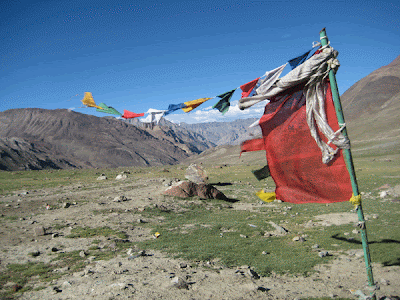
When we climbed up all the mountains, this is how Spiti Valley invited us! Prayers flags at the monastery.
Considering the sweltering heat and 'power-cut' in the Capital (New Delhi), it was literally an escapade to the cooler heights of Manali even if the over night journey took around 15 hours by bus. It's been almost 8 years since the last visit and I wasn't sure what to expect from Manali. Was worried if it has also become another Shimla or Ooty two of the most famous hill stations in the country. Unplanned 'growth' and 'politician-land mafia' nexus has destroyed these once beautiful hill stations. (Imagine drought and traffic pollution up in the mountains!).

Contrary, Manali for some reasons remain clean and I did'nt see that much of infrastructure development to the scale of what has happened in Shimla and Ooty. Even when Delhi and surrounding regions are braving heat, there were not many domestic tourists. There were quite a lot of foreigners though.

In a nut shell, Manali still looks beautiful, it's clean and the market still has its uniqueness. It's still a pleasure to walk around even within the town, and not to talk about the immediate vicinity with it's breath-taking mountain and river views! With a wonderful company in Gulshan, we went around tasting some mouth watering local food! (BTW, after not being in touch for almost 5 years, we met each other through facebook and decided to travel together in an impulse!)

One of the difference from last visit to Manali was the absence of polythene bags in shops. All the shops we went were giving bags made out of old newspapers. That's quite an achievement considering the fact that the initiative has failed in many places including Kerala and Tamilnadu. Though the city looks cleaner, many picnic spots out in the woods were littered as you can see from the photographs. Frankly to my surprise, I was impressed to see some boys taking back their garbage after their picnic. After all, albeit slowly, we are becoming sensitive to the environment.

So far the trip has been fabulous and I hope I will be able to keep everyone posted once in a while. Like in many other trips, we ended up meeting couple of people and made instant connections. I can see that we will be working together with some of them in the immediate future.
All excited about the 12 hour driver by jeep to the mountains tommorow.
Manali © GP 2007

Contrary, Manali for some reasons remain clean and I did'nt see that much of infrastructure development to the scale of what has happened in Shimla and Ooty. Even when Delhi and surrounding regions are braving heat, there were not many domestic tourists. There were quite a lot of foreigners though.

In a nut shell, Manali still looks beautiful, it's clean and the market still has its uniqueness. It's still a pleasure to walk around even within the town, and not to talk about the immediate vicinity with it's breath-taking mountain and river views! With a wonderful company in Gulshan, we went around tasting some mouth watering local food! (BTW, after not being in touch for almost 5 years, we met each other through facebook and decided to travel together in an impulse!)

One of the difference from last visit to Manali was the absence of polythene bags in shops. All the shops we went were giving bags made out of old newspapers. That's quite an achievement considering the fact that the initiative has failed in many places including Kerala and Tamilnadu. Though the city looks cleaner, many picnic spots out in the woods were littered as you can see from the photographs. Frankly to my surprise, I was impressed to see some boys taking back their garbage after their picnic. After all, albeit slowly, we are becoming sensitive to the environment.

So far the trip has been fabulous and I hope I will be able to keep everyone posted once in a while. Like in many other trips, we ended up meeting couple of people and made instant connections. I can see that we will be working together with some of them in the immediate future.
All excited about the 12 hour driver by jeep to the mountains tommorow.
Manali © GP 2007
